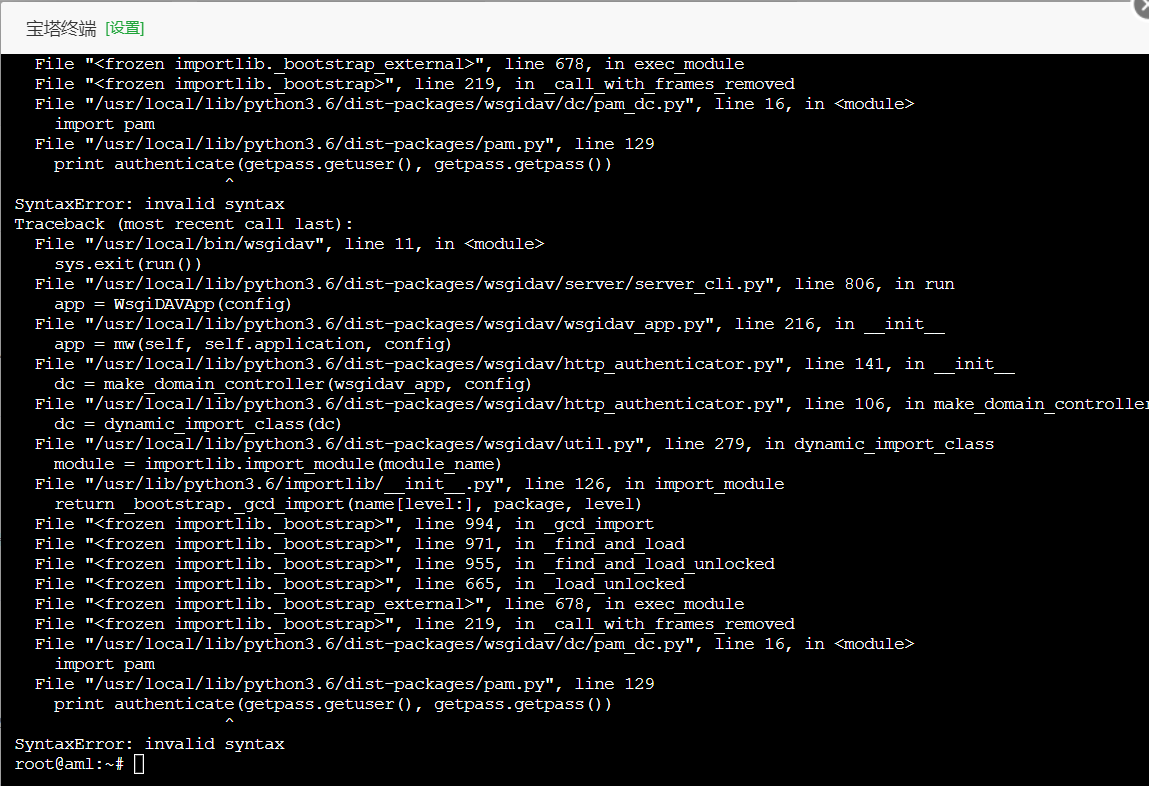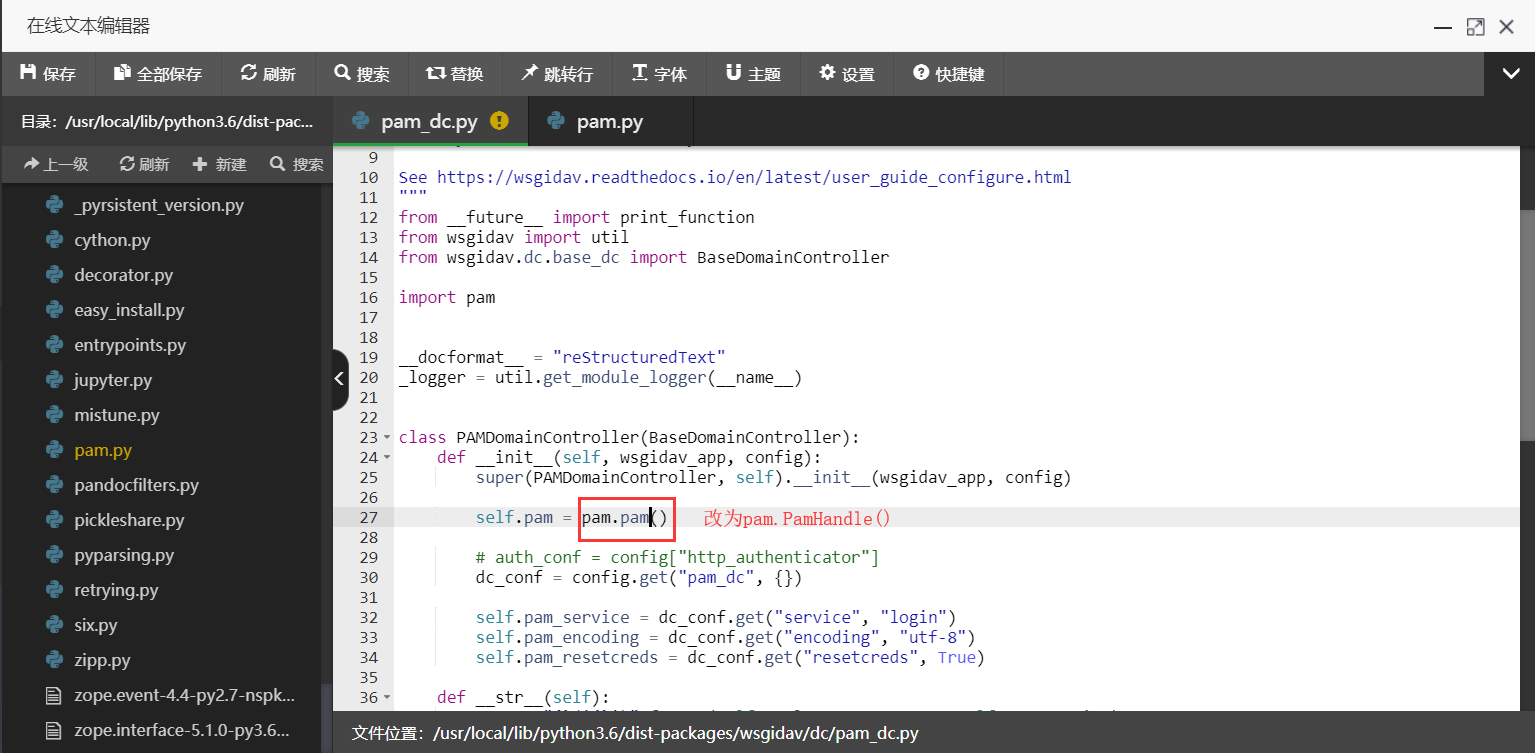一行python搭建webdav
本文于 960 天之前发表,文中内容可能已经过时。
想要建一个webdav,然后研究了apache,nginx均失败,最后还是python最简单地完成了我们的要求。
一、Wsgidav
- 官网:https://wsgidav.readthedocs.io/en/latest/index.html
- 安装
1
pip install cheroot wsgidav cheroot lxml pam
- 使用
1
2
3wsgidav --host=0.0.0.0 --port=80 --root=/tmp --auth=anonymous # 匿名
wsgidav --host=0.0.0.0 --port=80 --root=/tmp --auth=pam-login # Linux下账号
wsgidav --host=0.0.0.0 --port=80 --root=/tmp --auth=nt # Windows下账号
二、大问题
Ubuntu下实测,pam模块是有问题的。经过观察代码,这是python2时代的产物,而wsgidav采用pam来验证会带来一些坑。
坑1:字符报错,无效字符
python3的print有括号的,到该路径的文件中加上去即可
坑2:AttributeError: module ‘pam’ has no attribute ‘pam’
找到文件,随便改一下,能用就行。
坑3:Linux下密码登录失效,一直在报pam.authenticate错误。
重写,反正就我一个人用。把用户名密码写死!pam_dc.py文件全文如下。1
2
3
4
5
6
7
8
9
10
11
12
13
14
15
16
17
18
19
20
21
22
23
24
25
26
27
28
29
30
31
32
33
34
35
36
37
38
39
40
41
42
43
44
45
46
47
48
49
50
51
52
53
54
55
56
57
58
59
60
61
62
63
64
65
66
67
68
69
70
71
72
73
74
75
76# -*- coding: utf-8 -*-
# (c) 2009-2020 Martin Wendt and contributors; see WsgiDAV https://github.com/mar10/wsgidav
# Licensed under the MIT license: http://www.opensource.org/licenses/mit-license.php
"""
Implementation of a domain controller that allows users to authenticate against
a Pluggable Authentication Module ('PAM').
Used by HTTPAuthenticator. Only available on linux and macOS.
See https://wsgidav.readthedocs.io/en/latest/user_guide_configure.html
"""
from __future__ import print_function
from wsgidav import util
from wsgidav.dc.base_dc import BaseDomainController
import pam
__docformat__ = "reStructuredText"
_logger = util.get_module_logger(__name__)
class PAMDomainController(BaseDomainController):
def __init__(self, wsgidav_app, config):
super(PAMDomainController, self).__init__(wsgidav_app, config)
self.pam = pam.PamHandle()# origin is pam.pam, replace it
# auth_conf = config["http_authenticator"]
dc_conf = config.get("pam_dc", {})
self.pam_service = dc_conf.get("service", "login")
self.pam_encoding = dc_conf.get("encoding", "utf-8")
self.pam_resetcreds = dc_conf.get("resetcreds", True)
def __str__(self):
return "{}('{}')".format(self.__class__.__name__, self.pam_service)
def get_domain_realm(self, path_info, environ):
return "PAM({})".format(self.pam_service)
def require_authentication(self, realm, environ):
return True
def verify(self, user_name,password):# write die, 写死
if user_name=='lankning' and password=='123456':
return True
else:
return False
def basic_auth_user(self, realm, user_name, password, environ):
pam = self.pam
is_ok = self.verify(user_name,password)
# pam.authenticate(
# user_name,
# password,
# service=self.pam_service,
# resetcreds=self.pam_resetcreds,
# encoding=self.pam_encoding,
# )
if is_ok:
_logger.debug("User '{}' logged on.".format(user_name))
return True
_logger.warning(
"pam.authenticate('{}', '***', '{}') failed with code {}: {}".format(
user_name, self.pam_service, pam.code, pam.reason
)
)
return False
def supports_http_digest_auth(self):
# We don't have access to a plaintext password (or stored hash)
return False这就可以用了。。。
参考:
赏
 支付宝打赏
支付宝打赏
 微信打赏
微信打赏
 支付宝打赏
支付宝打赏
 微信打赏
微信打赏
赞赏是不耍流氓的鼓励